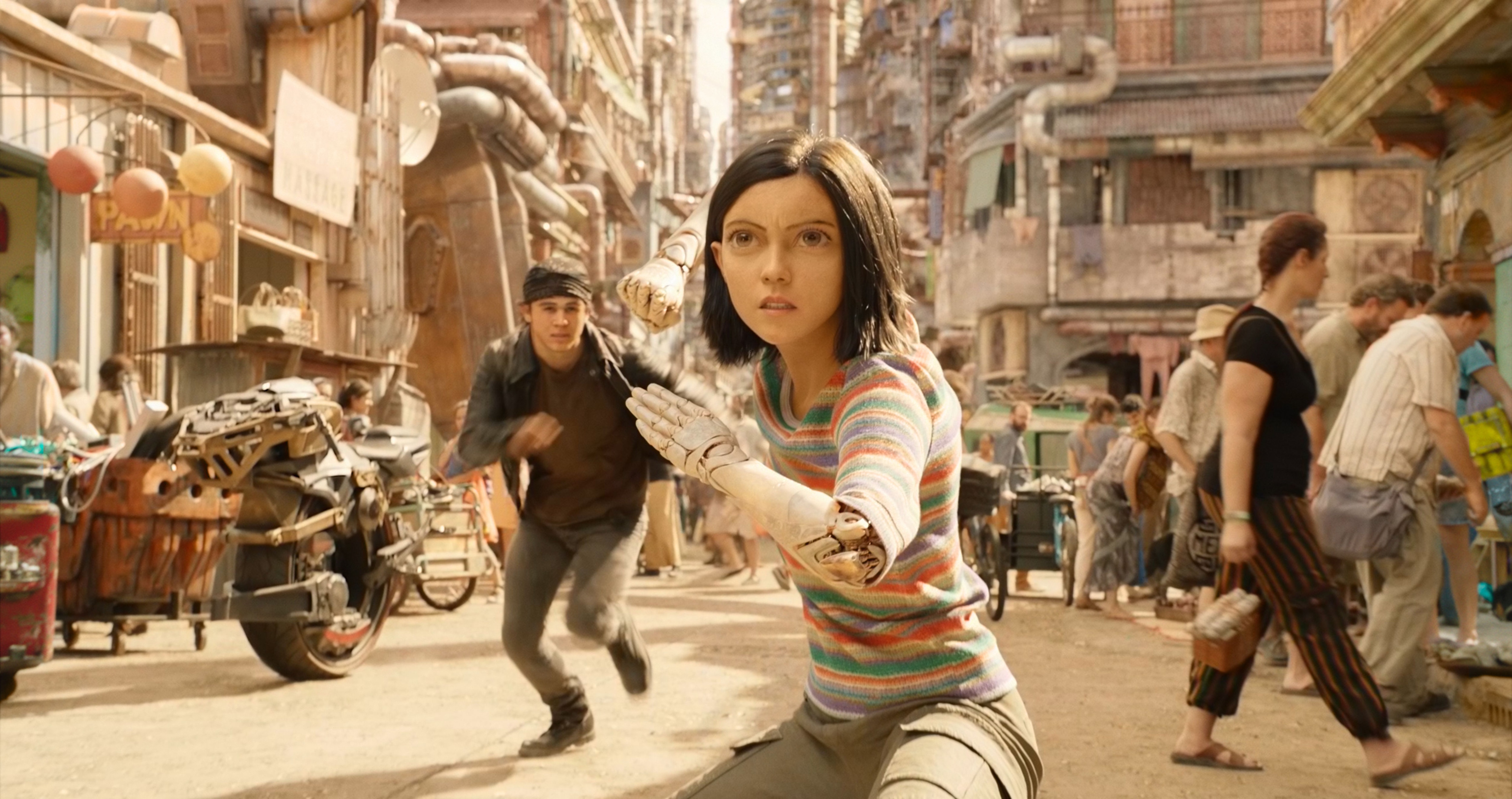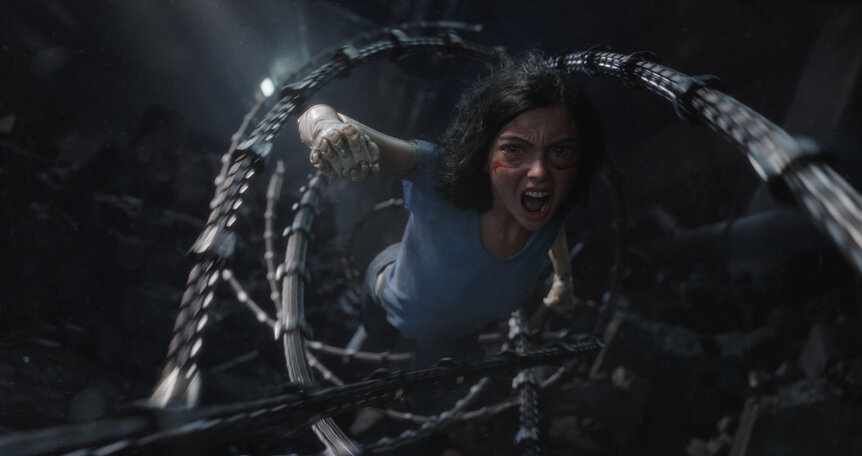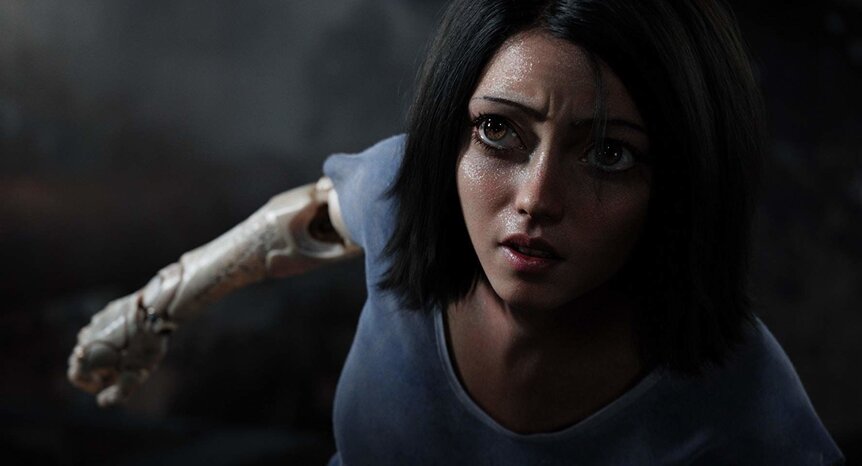Create a free profile to get unlimited access to exclusive videos, sweepstakes, and more!
The artists behind Alita: Battle Angel used some naughty real dogs to bring robots to life

Most of the headlines regarding the breathtaking effects of Alita: Battle Angel revolve around its central character, a completely CGI creation anchored by the soulful performance of star Rosa Salazar — and for good reason.
"Having Rosa on screen for every single shot that she was in — an hour and a half of screen time — is a lengthy endeavor," say Lightstorm Entertainment Visual Effects Supervisor Richard Baneham. "But the value of having her on the set and interacting as an actor was the single biggest thing that we could we could possibly do technically."
That said, the world of Iron City is one with a lot more to it than just the robot girl at its core. In the film directed by Robert Rodriguez and produced by James Cameron, naive Alita encounters other variations of robots and cyborgs, struggling to survive in this dangerous post-apocalyptic landscape — one brought to life by a team including Baneham, Animation Supervisor Mike Cozens, VFX Supervisor Richard Hollander and Visual Effects Supervisor Eric Saindon.
For these sequences, the artists drew upon all their resources, including their own pets. They explain how they did it, and why it was so important to make sure as much as possible on set was as real as possible, below.
One aspect of the film that hasn't gotten a ton of attention are the scenes featuring McTeague's (Jeff Fahey) robot dogs. How did the process of creating those characters work?
Mike Cozens: We brought in animators' dogs, and we did a couple sessions capturing dog performance. We used that to prep shots.
Eric Saindon: One of the dogs is based on my dog — the Australian Shepherd. She doesn't do much.
What's your dog's name?
Eric Saindon: Banjo.
Banjo is a good dog name.
Eric Saindon: She's not such a good dog.
In terms of getting reference footage of the dogs, was it just watching dogs do dog things?
Mike Cozens: Oh no, we actually put dogs in little motion capture performance capture suits, and we combine that with reference footage of police dogs jumping and attacking. The vocabulary that you're talking about is really grounding it in reality as much as we can.
Richard Baneham: We're talking about capturing the kinematics — capturing the skeleton. The specific skeletal makeup of any character, creature or animal, is based upon the biomechanics of that particular character or creature. So the limb length informs how a dog or an animal negotiates its own physical presence. If you look at a greyhound, a greyhound's rear legs pass beyond its forelegs, whereas you know, most dogs don't do that. So to have a multitude of dogs captured, and understand the physical differences and how it informs vocabulary, it can then be extrapolated to and applied to a whole sequence.
Mike Cozens: Then, [the attack scene] is driven from Jackie [Earle Haley]'s performance, as they attack Jackie. We had to do a lot of keyframe performance on top to augment the capture that we had done and build top shots from there that it's a comp it was. There's plate photography in there, and then there are full digital shots.
Richard E. Hollander: Overall, on this, this is one area where for most of the film, everything that we were shooting was there — Rosa was always there on the set interacting with everybody. And I would have liked to have real dogs that were trained to go and attack Jackie, because I would have been really cool to see them wearing little motion capture suits, but you know, we didn't have that.
Richard Baneham: Nor do you want that! But Richard is happy to turn rabid dogs loose on an actor.
Richard E. Hollander: I have a maniacal sense that I won't express anymore. But we are sensitive to having as much there that we're not making up. That's my only point.
Mike Cozens: That's the thing — it gives you that true performance. And that was the big goal for this film.
Richard Baneham: Exactly. You picked an example where we had to cheat in a little in some ways, but pantomime is your enemy when it comes to bringing digital characters to the screen. So even the dogs — we actually had objects producing outside forces on Jackie, so that we had good moments of specific and physical performance that we're able to then use to supplement the keyframe animation and make sure that the important moments all stay in place. So, even though that is a very small example, that holds true for the whole movie, including Rosa's performance.
Richard E. Hollander: It makes it harder for us. But we have her credibility and we know her performance is there.
Eric Saindon: The other dog's real name was Lucy — the one Rosa picks up and it licks her face. That was a great moment, because she's interacting with a live dog, and it was Rosa interacting with the dog and it actually licked her face. We were able to keep all of that actual interaction with Rosa and put it onto Alita, and so you see the expression on her face when she gets licked by the dog. It was the same expression we got on Rosa.
Richard Baneham: That action sequence of having her dive under the sentry and then they have to escape it lead to some very complex animation choices about how to do how to work in a large mechanical object that's moving to a space at a cadence, whereby we have to position all the limbs to allow these exit strategies.
Mike Cozens: The thing I love about that moment is that layered thing where she's negotiating an out, and she's thinking and we're reading emotion on her face. Even during the action scenes in this film, we're always going back to character. That's the breakthrough with a lot of this work — you buy into the character 30 seconds into the film. You've stopped thinking about the character part of it and you're just into the story.
During a recent awards event, a member of your team mentioned that when there was a negative reaction to the first trailer, especially how big Alita's eyes were, James Cameron's reaction was "'F*** the haters.' We ended up going bigger and wider."
Eric Saindon: After the first trailer, [the character] was still being developed at that stage. We had only seen her with a certain amount of other live-action characters. So we went to Jim and Robert and said, Hey, so what are your thoughts on the comments and they pretty much both just said, no, we're actually going to go bigger on the eyes. At the end of the day, we went with less sclera [the whites of the eyes] and bigger with the iris. So you saw less white around her eyes, which actually just brought her to life with the other characters in a better way.
Richard Baneham: I think it allowed us to attain a relationship of iris to sclera that was more similar to Rosa. Because the activity of the lower eyelid and upper eyelid around the eye is essentially how we read the emotional expression of a person, and we do it instantly from the moment you meet somebody. In a split second, you're able to read whether somebody is happy, sad, angry — you know, whether it's going to be confrontational or it's going to be friendly.
Richard E. Hollander: In normal everyday life, we don't think of it. You assume it's there when you're watching, but when it's not there, you really notice.
Richard Baneham: You get it for free with an actor. Protecting [Salazar's] performance choices — that was our job. Our job is to get it up there [on screen].
Richard E. Hollander: Audiences are really interesting. When it gets down to performances that are human performances, they see a lot and they are sensitive to the just one thing being out of place.
Eric Saindon: I keep getting asked how much of Alita was Rosa — like, how much did we take from Rosa as a live-action element and photographically use on Alita? And I don't think anyone really realizes that she's just 100 percent digital, the whole way through the film.
Richard Baneham: But we used 100 percent of Rosa's performance.
This interview has been condensed and edited for clarity.




























